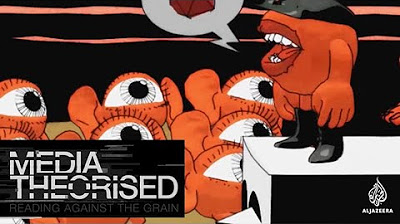Pluralist Approaches to Ownership and Control of the Media | The Media | AQA A-Level Sociology
Summary
TLDRThis sociology tutorial video explores the pluralist approach to media ownership and control. Pluralism emphasizes the variety of media sources available, reflecting diverse audience interests and needs. It contrasts with Marxist views by suggesting that media ownership is more dispersed and that content is driven by audience demand. The video discusses how media caters to different social groups and political ideologies, using examples like alternative news outlets and the impact of new media platforms. It also touches on the democratic nature of media, where audience choices shape content creation, and the economic motivations behind media production. Despite criticisms, pluralism maintains that the media landscape offers consumers a range of choices.
Takeaways
- 📚 Pluralism in media focuses on the variety of sources available and how they reflect diverse audience interests and needs.
- 🌟 Pluralists argue against Marxist views by stating that media ownership is more spread out and not concentrated in the hands of a few powerful entities.
- 🔍 The audience's demand influences media content, as owners cater to their preferences to maintain viewership and readership.
- 📈 Media is seen as a product driven by rational economics, with content creation based on market demand and profitability.
- 🌐 The rise of New Media, such as YouTube and blogs, offers a platform for alternative viewpoints and caters to niche audiences.
- 📰 Newspapers, both mainstream and alternative, reflect the pluralist view by providing a spectrum of political ideologies and interests.
- 📊 Media sources collect data on audience preferences to tailor content, ensuring they align with what the public wants to consume.
- 📺 Popular content formats are often replicated across different platforms to meet audience demand, as seen with reality TV shows.
- 💸 Media businesses rely on advertising revenue or subscriptions, which means they must create content that appeals to their audience to stay profitable.
- 🗳️ Pluralism views media as democratic, with content being a reflection of popular culture and audience choices shaping what is produced.
- 🤔 Criticisms of pluralism include the argument that media owners manipulate content to create a false sense of choice and promote false needs.
Q & A
What is the pluralist approach to the media?
-The pluralist approach to the media focuses on the wide range of media sources available to consumers and how these different forms of media reflect the interests and needs of the audience.
How does pluralism view media ownership compared to Marxist approaches?
-Pluralists argue that media ownership is more diverse compared to Marxist views, which focus on concentration of media ownership into the hands of a few powerful groups.
What role does audience choice play in the pluralist perspective of media?
-In the pluralist perspective, audience choice is central. Media owners and controllers look to represent the views of the audience by offering content that meets their demands.
How does the pluralist approach explain the existence of alternative media sources?
-Pluralists suggest that alternative media sources exist because media is driven by rational economics; if there is a demand for a specific type of content, media owners will create it.
What is an example of alternative media sources mentioned in the script?
-Examples of alternative media sources mentioned include Guido Fawkes, Breitbart, Novara Media, and The Canary, which provide alternatives to mainstream media.
How does the pluralist approach view the relationship between media and popular culture?
-Pluralists view media as democratic and promoting aspects of popular culture, with iconic moments from TV dramas and comedy becoming part of the cultural framework.
What is the role of advertising revenue and subscriptions in media production according to pluralism?
-According to pluralism, media sources are often based on advertising revenue or income from subscriptions, and this demand-led approach influences the content created to ensure profitability.
How does the pluralist approach respond to criticism that media promotes false needs and illusions of choice?
-Pluralists argue that despite criticisms, the range of media sources means that people still have a choice to switch over or click onto another website if they don't agree with the messages being promoted.
What does the pluralist approach suggest about the influence of the audience on media content?
-Pluralists suggest that the audience dictates content to a certain extent and even creates it, as seen in the rise of memes and social media engagement.
How does the pluralist approach view the impact of New Media on media diversity?
-The pluralist approach sees the explosion of New Media in the digital age as evidence of increased choice and diversity, even if the majority of media promotes similar ideals.
Outlines

هذا القسم متوفر فقط للمشتركين. يرجى الترقية للوصول إلى هذه الميزة.
قم بالترقية الآنMindmap

هذا القسم متوفر فقط للمشتركين. يرجى الترقية للوصول إلى هذه الميزة.
قم بالترقية الآنKeywords

هذا القسم متوفر فقط للمشتركين. يرجى الترقية للوصول إلى هذه الميزة.
قم بالترقية الآنHighlights

هذا القسم متوفر فقط للمشتركين. يرجى الترقية للوصول إلى هذه الميزة.
قم بالترقية الآنTranscripts

هذا القسم متوفر فقط للمشتركين. يرجى الترقية للوصول إلى هذه الميزة.
قم بالترقية الآنتصفح المزيد من مقاطع الفيديو ذات الصلة

Media Ownership: Crash Course Media Literacy #8

Branches of Sociology @sociologylearners1835

1.1 The process of learning and socialisation

Neo Marxist View of Media Ownership and Control | The Media | AQA A-Level Sociology

Noam Chomsky - The 5 Filters of the Mass Media Machine

TYPES of DEMOCRACY [AP Government Review Unit 1 Topic 2]
5.0 / 5 (0 votes)
